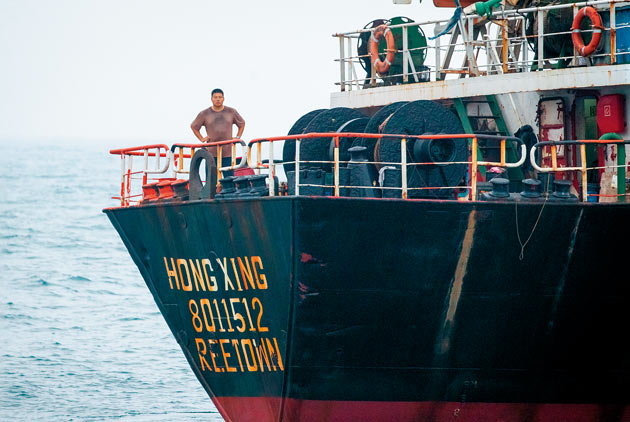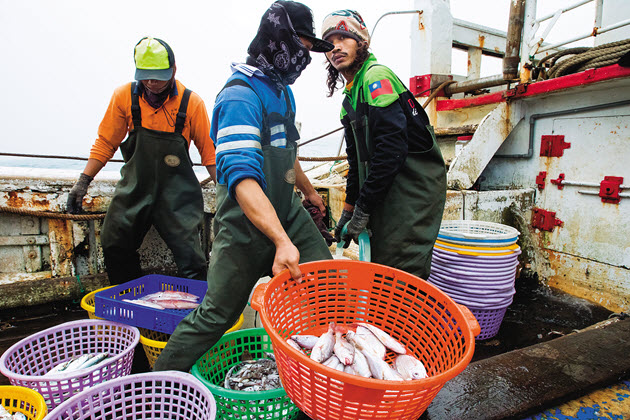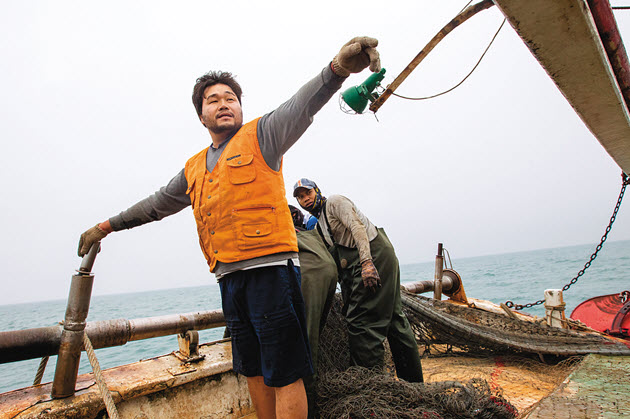Fish Depletion in the Taiwan Strait
A China-made Environmental Catastrophe

Source:Chieh-Ying Chiu
CommonWealth Magazine reporters went out on the Taiwan Strait to tell the story of the mullet trade. What they saw was the encroachment of Chinese fishing boats in Taiwanese waters and the environmental catastrophe those vessels are creating.
Views
A China-made Environmental Catastrophe
By Kuo-Chen Lu, Kuang-Yin LiuFrom CommonWealth Magazine (vol. 616 )
If you’re looking for an aquatic product that tells Taiwan’s story on the international stage, “it’s mullet roe. It best represents Taiwan,” says food expert Andy Hsu (徐仲).
During the peak mullet catching season around the start of winter, CommonWealth Magazine reporters set out on a fishing boat from Wuqi port in Taichung to gain insight on Taiwan’s mullet roe narrative. But just 12 nautical miles from Taiwan’s coast, a group of Chinese fishing boats led by two refueling ships appeared, reflecting the new calamity in the Taiwan Strait.
On that day, not long after the end of the New Year’s Day holiday, the boat’s captain Huang Chao-chan (黃昭展) takes a look at his radar scanner and observes: “Chinese fishing boats have already crossed the line [median line of the Taiwan Strait] to just offshore. I want to stress offshore because they are within 8 to 9 nautical miles of the coast. Vessel 0356 is already navigating around our baseline. Vessel C0085 0411 sometimes enters waters just off Taichung Port, which is already inside the 5-nautical-mile baseline. Those are our coastal waters. To put it bluntly, they’ve already reached our river beds.”
The baseline Huang referred to is the line hugging a country’s coast from which its territorial waters and exclusive economic zones are calculated.
Blast Fishing in the Taiwan Strait
Every winter, mullet rich in roe swim from north to south before ending their trek in waters off Taiwan. When Chinese fishing vessels flock to Taiwanese waters illegally, these mullet, whose roe is in high demand, are one of their main targets.
When the ship CommonWealth reporters traveled on had a chance encounter with a Chinese fishing fleet on the eastern (or Taiwan) side of the Taiwan Strait’s median line, it came as a bit of a surprise that the first ships we saw were two large refueling ships that were anchored within Taiwan’s 12-nautical-mile territorial waters.
Workers on the refueling ships were busy filling up one fishing boat after another, after which the fishermen immediately dropped their nets to catch fish. When their holds are full, they transfer their catches to a fish transportation ship headed to a Chinese port. The fleets are like worker bees operating day and night that have turned the Taiwan Strait into their own waters.
 Though it should be peak season for mullet, not one was caught on this Taiwanese fishing boat’s trip out to sea. Only a few small fish were caught, reflecting the depleted aquatic resources in the Taiwan Strait.
Though it should be peak season for mullet, not one was caught on this Taiwanese fishing boat’s trip out to sea. Only a few small fish were caught, reflecting the depleted aquatic resources in the Taiwan Strait.
As for Captain Huang’s fishing boat that went out to sea searching for mullet in the Taiwan Strait, it caught abandoned tires, discarded salad oil containers and small amounts of fish, but not a single mullet. Huang could only sigh and hope for better next year.
He notes, however, that it has been Taiwanese themselves who have cut their own throats.
Huang explains that Chinese consumers originally did not eat “fish that eat dirt” (actually algae), including mullet. Chinese fishing boats only began catching mullet in the late 1990s and 2000s. Taiwanese fish dealers, knowing that the Chinese did not eat mullet, began buying up the Chinese boats’ mullet catches at very low prices. They even taught the rival fishermen how to catch mullet and extract their roe.
Chinese fishermen quickly caught on that they could sell mullet catches to Taiwanese, and once they realized mullet roe was like gold with its huge profit margins, the nightmare began for Taiwanese fishermen.
The director of the Taichung Fishermen’s Association, Chao Chao-sen (趙朝森), explains that Chinese fishermen start intercepting mullet in waters off the Liaodong Peninsula as the fish start their southward migration to extract its roe to sell to Taiwanese. At that point, the mullet roe is not mature and still too small, but Chinese fishermen still go after mullet off the Liaodong Peninsula and down China’s coast off Shandong, Jiangsu and Zhejiang to Fujian and even Guangdong provinces.
As a migratory fish, mullet can be caught along whoever’s coast they swim by – they are not the exclusive property of Taiwanese. But to the mullet population as a whole, the fishing methods used by Chinese fishing boats are resulting in an environmental catastrophe.
Huang, the fishing boat captain, says Chinese fishing boats used dynamite fishing from the very beginning when going after mullet. They stun whole groups of mullet and then quickly release environmentally destructive trawl nets to sweep up and maximize the catch.
Too much dynamite was used at times, bursting the mullet’s internal membrane and breaking the eggs, making it impossible to sun-dry them. When Taiwanese distributors refused to accept the damaged roe, Chinese fishermen realized there was a problem and starting using smaller amounts of dynamite. The problem still exists on a smaller scale today.
Because of large-scale exploitation of mullet stocks, Taiwan now mostly buys mullet roe from Chinese fishing boats, with only a small number of fish that evade capture reaching Taiwan. Chao says the mullet roe sold by Chinese sources is about 33 percent cheaper than that sold by Taiwanese suppliers.
Huang Hung-yan, a deputy director-general of the Fisheries Agency under Taiwan’s Council of Agriculture, says some Taiwanese have even invested in mullet roe processing facilities in China. The delicacy has even been documented on the Chinese TV series “A Bite of China,” spawning a growing community of Chinese consumers who appreciate the product.
Today, Taiwan’s mullet industry has been blown to bits and fished out of existence by Chinese fishing boats, to the point that local mullet processors must rely on harvested mullet to survive.
Taking Bribes but Still Making Arrests
The mullet roe story epitomizes the huge threat to Taiwan’s fishery resources posed by Chinese fishing boats.
Taiwan has gradually developed an environmental consciousness that includes preserving its marine ecosystem. In 1999, the Fisheries Agency declared the country’s 12-nautical-mile territorial waters a conservation area closed to large bottom trawlers so that coastal waters can recuperate from the ravages of overfishing.
The agency also plan to ban the use of gill nets, which are suspended vertically in water to catch the gills of fish as they try to get their heads through the nets, within 3 nautical miles of Taiwan’s coast.
Chinese fishing boats, however, have paid no attention to the bans, encroaching into Taiwan’s restricted waters at will. Those incursions have completely undermined Taiwan’s policies to ban fishing in sensitive areas and restore its marine resources.
There are even fishermen who travel on expressways along Taiwan’s western coast who can spot Chinese fishing boats operating in coastal waters within 3 nautical miles, says Allen Chen (陳昭倫), a research fellow at Academia Sinica’s Biodiversity Research Center.
So how serious is the problem?
Chen Jian-yu (陳建鈺), who runs the biggest fishing company in central Taiwan – Hou-Shi Fishery Products – explains that China’s economic reforms and market openings changed the nature of its fishing industry by encouraging fishermen who worked as part of communes to set up their own small businesses.
“It represented a huge change. At the time, Taiwanese fishing boats cast their nets three times a day, but in the era of Chinese communes, Chinese boats would only cast their nets once every three days. As long as they went out and cast their net, they could say they did their job and collect their pay when they returned to port.
But things changed dramatically once Chinese could set up their own small businesses. Taiwanese boats continued to cast their nets three times a day, but Chinese fishermen suddenly were going for six catches a day.
“We would catch fish during the day and rest at night, but they were out there day and night, even in strong winds. They weren’t afraid of anything. In fact, the harder the wind blew, the more they enjoyed catching fish because they felt more emboldened to fish closer to Taiwan waters,” Chen says.
Chinese fishermen have even bribed Taiwanese Coast Guard officers without the slightest reservation.
Chao of the Taichung Fishermen’s Association observes that many Chinese fishing boats are the most environmentally destructive bottom trawlers, and they have been especially active in waters off Hsinchu and Miaoli.
There was even a Coast Guard officer who sold them information about two years ago, disclosing Coast Guard shift schedules to Chinese fishing boats so they could fish illegally in Taiwan waters while avoiding Coast Guard patrols, Chao recalls. The officer was eventually indicted on corruption charges, and the case is now in the appeal stage.
“During the trial hearing, a crew member of a Chinese fishing boat even complained how ‘your Taiwan Coast Guard could take money and still arrest people at the same time,’” Chao says.
Also damaging to the environment is the massive amount of fish caught by Chinese fishing boats. As China has grown more affluent, the hulls of vessels used have gone from wood to steel and the ships themselves have gotten bigger. In some cases, steel-hull Chinese fishing boats have bigger tonnages than do Taiwanese Coast Guard patrol boats.
All that has added up to a recipe for disaster, according to Huang Chao-chan, the fishing boat captain, and Chen Jian-yu agrees.
 Fishing boat captain Huang Chao-chan takes part in the sustainable seafood movement. He wants people to gain greater awareness of local oceans and seafood so that they can be better preserved.
Fishing boat captain Huang Chao-chan takes part in the sustainable seafood movement. He wants people to gain greater awareness of local oceans and seafood so that they can be better preserved.
“In looking at the amount of fish Taiwan catches, it’s not close to what Chinese provinces catch and it’s not even comparable to what single Chinese ports pull in,” Chen laments. Xiangzhi Port in Fujian province alone, for example, is home to nearly 1,000 steel-hulled boats.
The capacity of Taiwan’s fishing vessels ranges from 20 tons to just over 200 tons, while that of vessels in Xiangzhi go from over 200 tons to 400 to 500 tons. In effect, one Chinese ship equals five Taiwanese vessels, and consequently Xiangzhi Port has the equivalent of 4,000 Taiwanese ships.
Aggressive Chinese fishermen and a huge fleet of high-tonnage fishing boats pose a massive threat not just to Taiwanese fishermen but to fishermen from other countries.
“Chinese fishing boats have severely depleted marine resources. Taiwan isn’t the only one concerned. Other countries in the region like Japan and South Korea have also run into problems with Chinese overfishing,” the Fisheries Agency’s Huang Hung-yan says.
The environmentally calamitous practices of the Chinese have taken their toll on other species beyond mullet. Narrow-barred Spanish mackerel and Indo-Pacific king mackerel – commonly used in daily fare like thick soups in Taiwan – have also seen their stocks plunge precipitously and their prices soar. Like mullet, these two types of mackerel are migratory fish that navigate down China’s coast into the Taiwan Strait.
A Headache for Taiwan, Japan, Korea
The challenge faced by Taiwan and other countries in the region is whether or not the problem can be managed. For Taiwan in particular, can it get Chinese fishing boats to respect Taiwanese fishing regulations and have them abstain from dynamite fishing or other methods that destroy marine resources and stay out of restricted Taiwanese waters?
Academia Sinica’s Allen Chen argues that the Act Governing Relations between the People of the Taiwan Area and the Mainland Area limits how Taiwan can respond. Local authorities cannot take any action against Chinese fishing boats unless they cross over the median line of the Taiwan Strait or engage in illegal behavior, in which case Taiwan could ban or punish the boats or even seize them, he says.
By comparison, however, South Korea has doused Chinese fishing boats encroaching in its waters with artillery fire and sunk them, and Indonesia has seized illegal Chinese fishing boats and then gathered them together and used explosives to sink them. These actions illustrate the limitations of Taiwan’s deterrence of these Chinese pests.
As for the Chinese use of destructive fishing practices, including blast fishing and overfishing, early in the migration of several fish species, the Fisheries Agency’s Huang says Taiwan constantly reminds China that migratory species are the common resource of the Taiwan Strait and that fishing without effectively managing their stocks will lead to their extinction.
Adds Chen Jian-yu, “If China did not impose a two- to three-month moratorium on fishing every year, all the fish in the Taiwan Strait would have been caught a long time ago.
CommonWealth's pursuit of mullet on the high seas revealed a simple truth: Taiwan’s 355-year-old mullet story is clearly changing tunes. With the rise of China’s fishing industry and the serious depletion of narrow-barred Spanish mackerel and Indo-Pacific king mackerel stocks, efforts by Taiwan alone to join the global “slow-fishing” movement will be completely inadequate in restoring the Taiwan Strait’s precious marine resources.
“Slow-fishing” has emerged as a common topic among Taiwan’s neighboring countries, but if it cannot be jointly implemented, Taiwan’s waters will never again be home to rich schools of fish, and beautiful marine ecologies will turn into barren wastelands.
Translated from the Chinese by Luke Sabatier
► 'Slow Fish' Special Report Related Articles:
♦ Slow Fish/
Where Does Our Fish Come From?
♦ Ecological Aquaculture/
Giving Our Seas a Break







